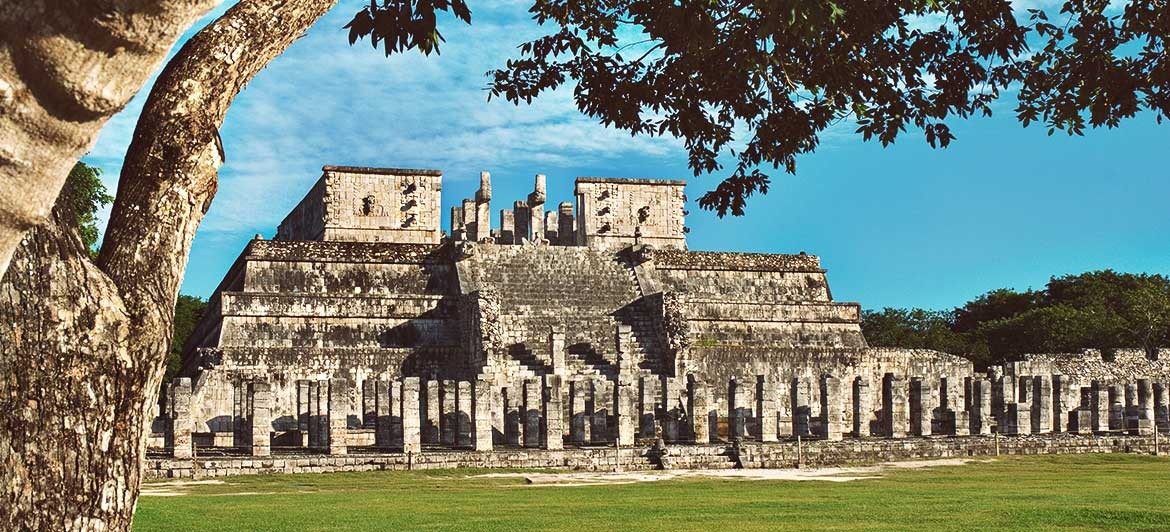Chichén Itzá is an ancient Mayan city located in the Yucatan Peninsula of Mexico. The site contains a variety of architectural styles and features, including pyramids, temples, and plazas, and is considered one of the most important archaeological sites in Mexico and Central America.Chichén Itzá was founded around the 5th century AD and grew to become one of the largest and most influential cities in the Mayan world. The city was a major center of trade, religion, and politics, and was home to a diverse population of farmers, artisans, priests, and nobles.The most iconic feature of Chichén Itzá is the Temple of Kukulcan, also known as El Castillo. This pyramid-shaped temple was built around 1000 AD and is dedicated to the feathered serpent god Kukulcan. The temple is known for its intricate carvings, including the famous serpent heads that adorn the base of the temple's staircase. These heads are designed to create the illusion of a descending serpent during the spring and autumn equinoxes.
Another notable feature of Chichén Itzá is the Great Ballcourt, the largest and most impressive ball court in the ancient Maya world. The court measures 168 meters in length and 70 meters in width and features stone rings located high on the walls that players would use to score points by hitting the ball through them.The city was abandoned in the 15th century, and the ruins remained largely unknown to the outside world until the 19th century. Today, Chichén Itzá is a popular tourist destination and a UNESCO World Heritage site, attracting millions of visitors each year.Despite its popularity, Chichén Itzá faces a number of challenges, including deterioration due to weather and tourism, as well as ongoing controversies related to the site's management and access. Efforts are underway to preserve the site and promote sustainable tourism practices, but the future of Chichén Itzá remains uncertain.Chichén Itzá was not only a major cultural and religious center, but it was also a hub of trade and commerce. The city was strategically located at the intersection of major trade routes, connecting the coastal cities of the Yucatan with the inland cities of Central America. As a result, Chichén Itzá was able to control and tax a large portion of the trade that passed through the region, making it one of the wealthiest cities in the Maya world.
In addition to the Temple of Kukulcan and the Great Ballcourt, Chichén Itzá is home to numerous other impressive structures, including the Temple of the Warriors, the Temple of the Jaguar, and the Observatory. These buildings feature intricate carvings and decorations, reflecting the highly advanced artistic and architectural skills of the Mayan civilization.Chichén Itzá was also known for its advanced knowledge of astronomy and mathematics. The city's astronomical observatory, known as El Caracol, features a domed tower that allowed astronomers to track the movements of the stars and planets with remarkable precision.The decline of Chichén Itzá is still a topic of debate among historians and archaeologists. Some theories suggest that the city was abandoned due to environmental factors such as drought, while others point to political instability or invasion by outside forces. Regardless of the cause, the legacy of Chichén Itzá continues to fascinate and inspire visitors from around the world.Another interesting aspect of Chichén Itzá's history is its relationship with other Mayan city-states in the region. At its height, Chichén Itzá was one of the most powerful city-states in the Yucatan Peninsula, and it maintained close ties with other major cities such as Uxmal, Mayapán, and Tikal. These alliances were often formed through political marriages between ruling families, and they allowed for the exchange of goods, ideas, and cultural practices.
One of the most intriguing examples of Chichén Itzá's intercity connections is the presence of Toltec-style architecture and iconography in the city. The Toltecs were a powerful Mesoamerican civilization that flourished in central Mexico in the centuries before the arrival of the Spanish. Although Chichén Itzá was located hundreds of miles from the Toltec heartland, the city's architecture and artwork show clear influences from Toltec culture. This suggests that Chichén Itzá may have had direct contact with the Toltecs, or that the two cultures shared a common artistic and cultural heritage.Today, Chichén Itzá is one of the most popular tourist destinations in Mexico, attracting millions of visitors each year. However, the site's popularity has also brought challenges related to preservation and sustainable tourism. In recent years, efforts have been made to limit the number of visitors to the site and to promote responsible tourism practices. These efforts include implementing a fee to enter the site, restricting access to certain areas, and encouraging visitors to follow guidelines for respectful behavior and environmental protection.
One of the most impressive features of Chichén Itzá is the Great Ballcourt, which is the largest and best-preserved ballcourt in Mesoamerica. The ballgame was an important religious and cultural practice in many ancient Mesoamerican societies, including the Maya. Players would use their hips, elbows, and knees to hit a rubber ball through stone hoops attached to the walls of the court. The game had strong religious significance, with some versions involving human sacrifice.Chichén Itzá was abandoned by the end of the 15th century, likely due to a combination of environmental factors and political instability. The city was rediscovered by Europeans in the 19th century, and it has since become one of the most iconic examples of Mayan civilization. The site was declared a UNESCO World Heritage site in 1988, and it continues to fascinate visitors with its stunning architecture, rich history, and cultural significance.







_tr14.jpg)

0 Comments